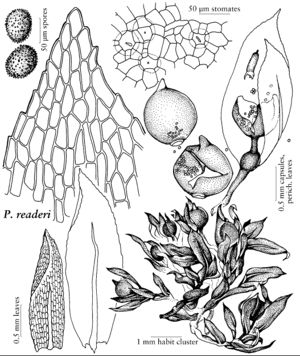Physcomitrella
Bryol. Europ. 1: 13. 1849 ,.
| Taxon | Illustrator ⠉ | |
|---|---|---|
 | Physcomitrella patens | Patricia M. Eckel |
 | Physcomitrella readeri | Patricia M. Eckel |
Plants small, scattered to gregarious. Stems 3–3.5 mm, erect, simple or forked. Leaves somewhat crisped when dry, erect-spreading when moist, lanceolate, ovatelanceolate, or obovate, plane to weakly concave, 2–2.5 mm; margins entire to serrulate distally; apices acuminate; costa single, extending 1/2–2/3 of the leaf length, occasionally slightly forked at apex, or percurrent; proximal laminal cells rectangular, distal cells short-rectangular to rhombic with narrow ends. Sexual condition paroicous. Seta erect, to 0.2 mm. Capsule cleistocarpous, erect, immersed, symmetric, globose and apiculate, to 0.8 mm, wrinkled upon aging; exothecial cells irregular in shape, usually thin-walled; stomata with single guard cell, restricted to base of capsule, superficial; annulus none; operculum not differentiated, dehiscence irregular; peristome absent. Calyptra conic-mitrate, not or slightly lobed, small, covering apiculus of capsule only, smooth. Spores spherical to slightly elliptical, densely papillose to slightly spinulose.
Distribution
North America, c, n Europe, Asia (China), Asia (Japan), Asia (w Siberia), Africa, Australia
Discussion
Species 2 (2 in the flora).
Physcomitrella is distinguished from other Funariaceae by the immersed capsule with irregular dehiscence, and the thin-walled, translucent exothecial cells. The generic name implies a resemblance to Physcomitrium, which is named, however, for its large calyptra, unlike that of Physcomitrella.
Selected References
None.
Lower Taxa
Key
| 1 | Costa extending to at most 2/3 the length of the leaf. | Physcomitrella readeri |
| 1 | Costa extending to leaf apex. | Physcomitrella patens |